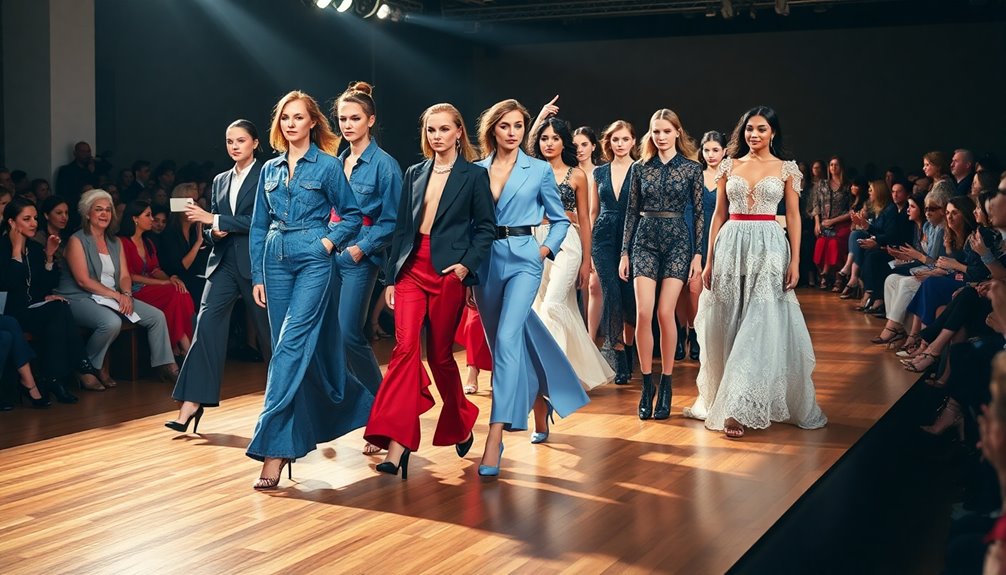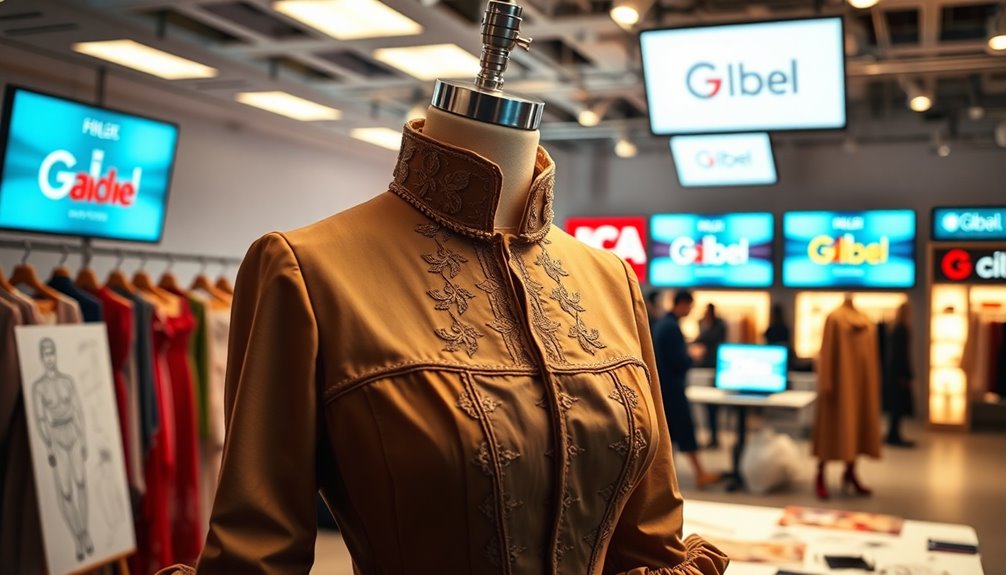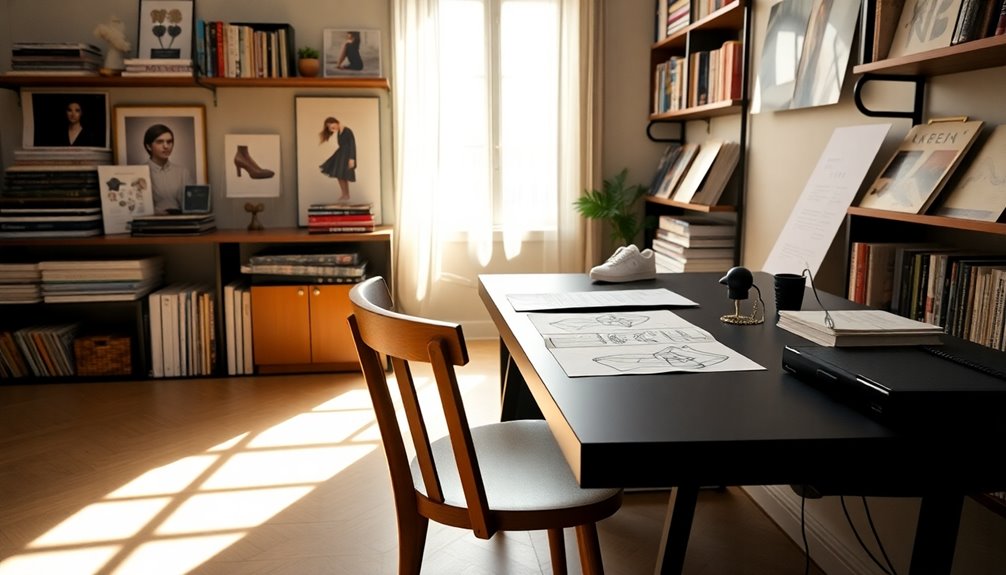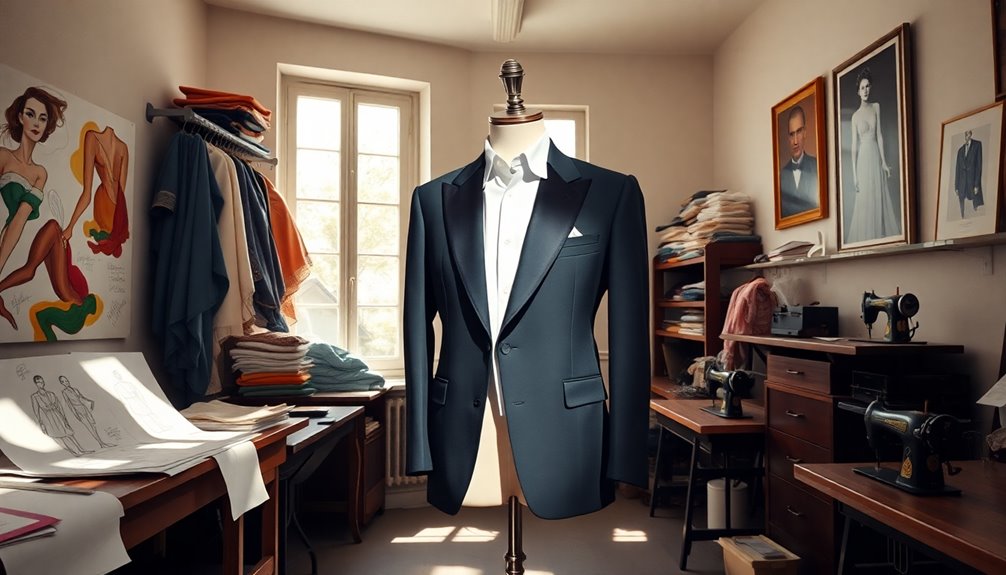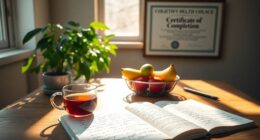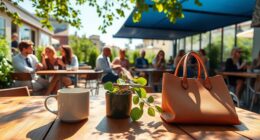To navigate the dynamic world of fashion design, you'll want to grasp essential terms that shape the industry. Start with "silhouette," which defines a garment's overall shape. Understanding a "mood board" helps you visualize concepts, while a "trend board" captures upcoming styles. Mastering "flat drawings" and "tech packs" ensures clear communication with manufacturers. Don't forget about "colorway," as it greatly impacts a design's appeal. Exploring different types of fashion, like haute couture, enriches your insight. Stick around, and you'll uncover even more critical terms to enhance your fashion knowledge.
Key Takeaways
- Silhouette: The overall shape of a garment, influencing body perception and design style through variations like A-line, sheath, and mermaid.
- Mood Board: A visual tool that organizes design concepts, showcasing images, color palettes, and textures to inspire creativity and guide communication.
- Flat Drawing: A technical representation of garment construction that effectively conveys design details and specifications to manufacturers and sample makers.
- Tech Pack: A comprehensive document outlining garment specifications, including sketches and material lists, ensuring clear communication and accurate production.
- Fit Session: An evaluation process where sample garments are tested for comfort and style, allowing for adjustments based on real-time feedback from models.
Silhouette

Silhouette is the foundation of any outfit, representing the overall outline or shape a garment creates when worn. When you choose an outfit, the silhouette is often the first aspect you notice. It can transform how you perceive your body, creating the illusion of different proportions.
Designers focus on distinct silhouettes, using shapes like A-line, sheath, hourglass, and mermaid to evoke specific styles and moods. The cut and style of a garment heavily influence its silhouette. For instance, a natural silhouette follows your body's contours, while a sheath silhouette hugs your curves for a sleek look.
Factors such as sleeve length, shoulder width, and skirt volume all contribute to the overall effect. Details like pleats or ruffles can also modify the silhouette, adding dimension and interest. Additionally, the interplay of volume and shape is essential in silhouette design, influencing the overall aesthetic of the garment.
Moreover, the fabric and texture you choose play a significant role in defining how a silhouette appears. Some silhouettes may even evoke cultural or historical significance, reminding you of iconic fashion eras.
Ultimately, understanding silhouette helps you select outfits that not only flatter your body type but also communicate the mood you want to express.
Flat Drawing

Flat drawings serve as essential tools in fashion design, providing a clear visual representation of a garment's construction and design details. These sketches communicate your design ideas effectively to manufacturers and sample makers, helping to avoid misinterpretations during the sampling process. In the fashion industry, flat sketches are recognized as industry standard practice, ensuring that the first samples are as accurate as possible.
When creating a flat drawing, include key components like the garment's silhouette, seams, and structural details. Illustrate design elements such as buttons, zippers, pockets, collars, and cuffs, while also showing internal details and fastenings. Mark stitch lines, fold lines, and measurement indicators to clarify your design.
You can create flat drawings by hand or with vector tools like Adobe Illustrator or Inkscape, which allow for scalability and precision. Use templates and consistent line weights for a cohesive look.
Best practices involve maintaining accurate proportions and symmetry, applying fills and textures, and simplifying your drawings with straight lines. Lastly, don't forget to reference body measurements and garment specifics to ensure clarity for pattern makers.
Tech Pack
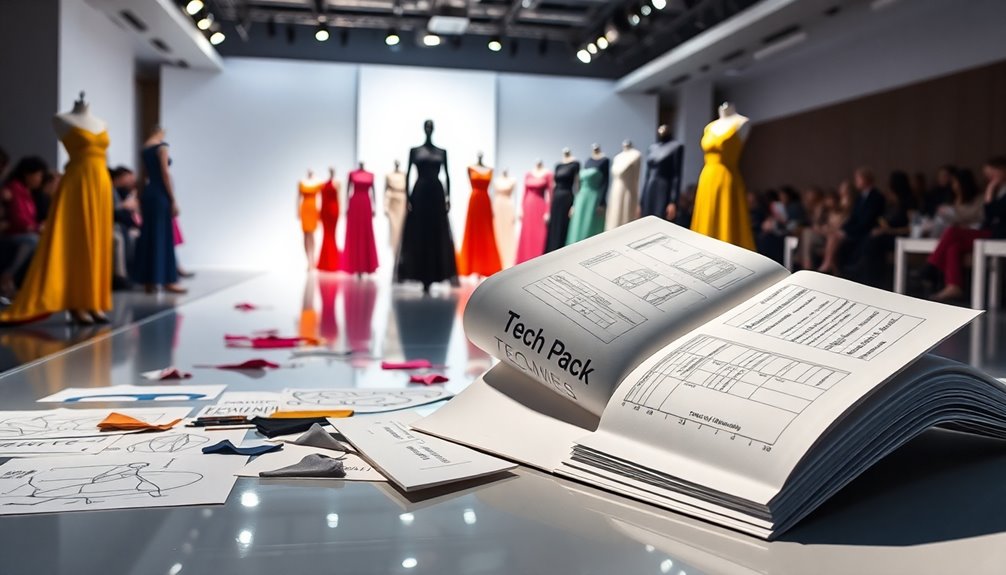
A tech pack is a crucial document in fashion design that lays out all the details needed to bring a garment from concept to production. It includes design sketches, technical drawings, and a bill of materials (BOM), which lists every fabric, trim, label, and packaging element required.
You'll also find measurement specifications to ensure consistent sizing and fit, along with colorways detailing all available color options.
The importance of a tech pack can't be overstated. It serves as a clear communication tool between you and manufacturers, minimizing misunderstandings and errors. By documenting every detail, it promotes consistency in the production process and streamlines operations, saving you time. Additionally, it plays a vital role in ensuring quality throughout the production cycle.
Moreover, it aids in accurate cost management and quality control, ensuring that the final product aligns with your standards.
Creating a tech pack involves collaboration with designers and technical experts, often utilizing CAD software for precision. This digital transformation enhances the quality of production while reducing guesswork.
Ultimately, a well-crafted tech pack is essential for bringing your vision to life and ensuring your designs are market-ready.
Mood Board
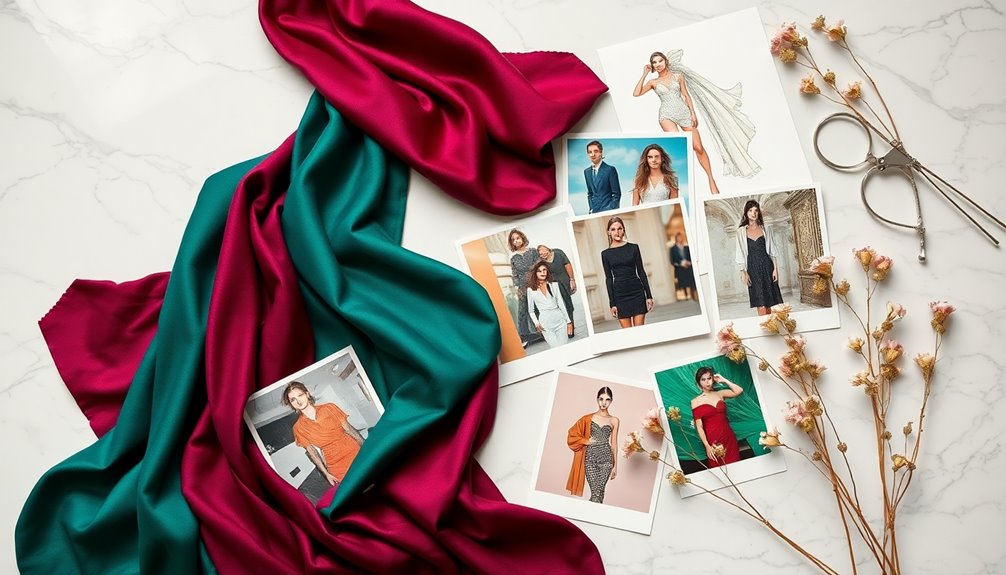
While crafting a fashion collection, a mood board becomes an invaluable tool that visually communicates your design concepts and ideas. This collage of images, materials, colors, and sometimes words translates your abstract thoughts into tangible forms. It helps you organize your ideas and experiment with different concepts, guiding you in creating a cohesive clothing line, outfit, or fashion show.
To start, define the purpose of your mood board, whether it's for a specific clothing line or a season. Research extensively by gathering inspiration from fashion magazines, books, and real-life observations. Include images like photographs, drawings, and artwork, along with color palettes crucial for setting the mood.
Don't forget to add textures and fabrics, such as fabric swatches, and even words or quotes that emphasize your theme. You can create your mood board digitally with tools like Photoshop or physically using cutouts. Refine and adjust it as your design concept evolves. In addition, mood boards are vital for fashion designers as they help convey creative visions and enhance communication with stakeholders.
Ultimately, a mood board sparks inspiration, enhances communication with clients and collaborators, ensures design cohesion, and serves as a reference point throughout your design journey, saving you time and keeping you focused on your vision.
Trend Board
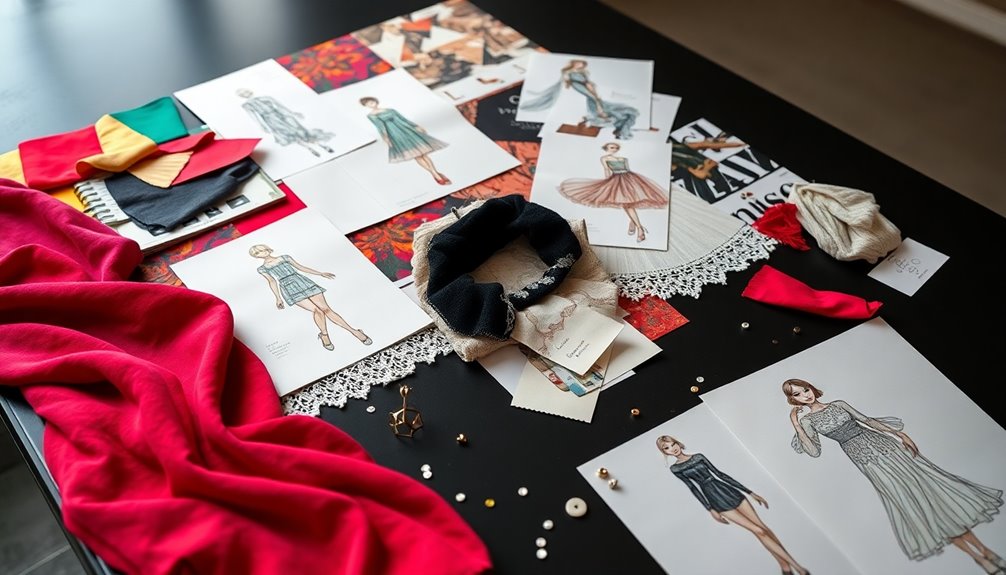
Trend boards are essential tools in fashion design that visually encapsulate the anticipated trends for upcoming seasons, helping you stay ahead in a fast-paced industry. They serve as a comprehensive visual layout that summarizes fashion market behavior, guiding your design process or impressing buyers with your collection's concept direction.
These boards typically include images, color swatches, fabric samples, and even sketches that represent identified trends. While some trend boards are physical, featuring three-dimensional elements, others leverage digital platforms like Photoshop for enhanced control over visuals. You can incorporate competitor brand elements to analyze the market effectively. Additionally, understanding the significance of historical context can further enrich your trend board by providing insights into past influences on current fashion.
Trend boards play a crucial role in setting a mood for your collection and ensuring cohesion across designs. They act as a reference point throughout your creative journey, helping you organize thoughts and experiment with different styles, textures, and colors. Additionally, they provide an overview of fashion market behavior that is essential for identifying upcoming trends. The incorporation of traditional healing practices in designs can also enhance cultural relevance and appeal. Furthermore, compiling a mood board can greatly enhance the creative process by visualizing design concepts.
Additionally, they facilitate clear communication of your vision to team members and stakeholders, making it easier to collaborate and refine ideas.
Whether specific or broad in scope, trend boards inspire creativity and assist in preparing for the upcoming fashion season, ensuring you're always aligned with current and future trends.
Seam
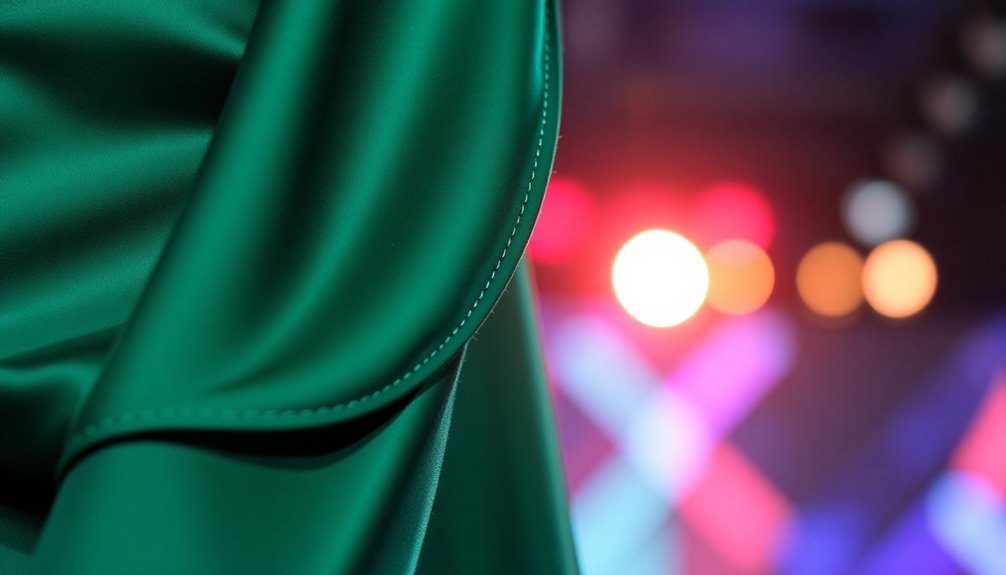
Creating a cohesive collection involves not just visual inspiration from trend boards but also understanding the various types of seams that hold your garments together. Seams are essential for garment construction, impacting quality, durability, and overall appearance. A well-constructed seam significantly contributes to the overall quality of the garment, ensuring that it performs well over time. Additionally, selecting the right seams can enhance your garments' fit and functionality, making them more appealing to customers. Modern sewing techniques, such as those used in dual-flush systems, can also improve garment construction efficiency. Additionally, learning basic sewing techniques can provide a strong foundation for mastering seam construction.
The plain seam is the most basic and versatile, perfect for shirts, skirts, and trousers. Just place two pieces of fabric right sides together and sew along the edge. A strong understanding of investment diversification can help ensure that your financial future is as solid as the seams in your garments. The choice of seams can also reflect the modern farmhouse style through the use of natural fabrics that enhance the overall aesthetic.
The French seam is ideal for delicate fabrics like silk; it encloses raw edges for a polished finish, making it great for blouses and lingerie.
For a decorative touch, consider the bound seam that encases raw edges with bias tape, often seen in unlined jackets and couture pieces.
The welt seam offers both structure and style, commonly found in denim and outerwear.
When selecting seams, match them to your fabric type and desired finish. Seams can enhance fit, provide structural support, and even introduce unique design elements.
A well-constructed seam is key to ensuring your garments not only look professional but also stand the test of time. Understanding these seam types will elevate your design skills and garment quality.
Pattern Block
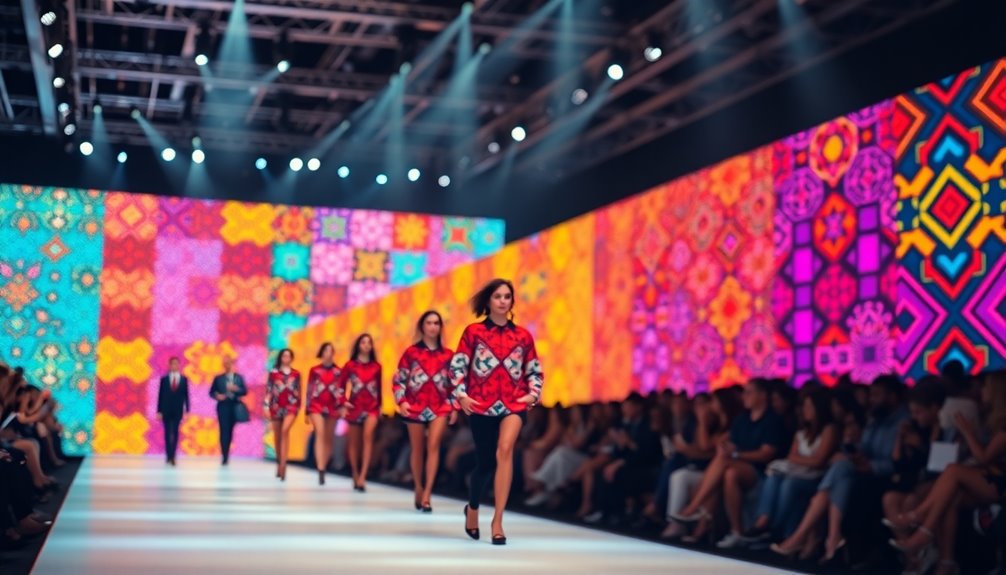
A pattern block is a designer's essential tool, serving as the foundation for crafting garments. It's a fundamental pattern that you can use to create more intricate designs. When drafting a block, you'll rely on specific body measurements to ensure the fit is just right. Common types of blocks include bodices, skirts, trousers, and sleeves.
Key features of a pattern block include wearing ease, which is the extra room that allows for comfortable movement, typically ranging from 2" to 4". Unlike finished patterns, blocks don't include design elements like lapels or pockets. You'll often find labels on blocks indicating names, sizes, or specific cutting notes. Additionally, standard basic blocks are designed to fit a demographic, providing a reasonable fit for multiple individuals.
In the design process, basic blocks play a pivotal role. They help you match your initial design concepts, allowing you to add elements that transform them into finished patterns.
Once you've fit-tested a block, you can store and reuse it as a reliable base, streamlining the pattern-making process and ensuring consistency in sizing.
Having a library of basic blocks can significantly speed up your workflow and help avoid common fitting issues. Adapt them for different fabrics, and you'll be well on your way to creating stunning garments.
Flat Pattern
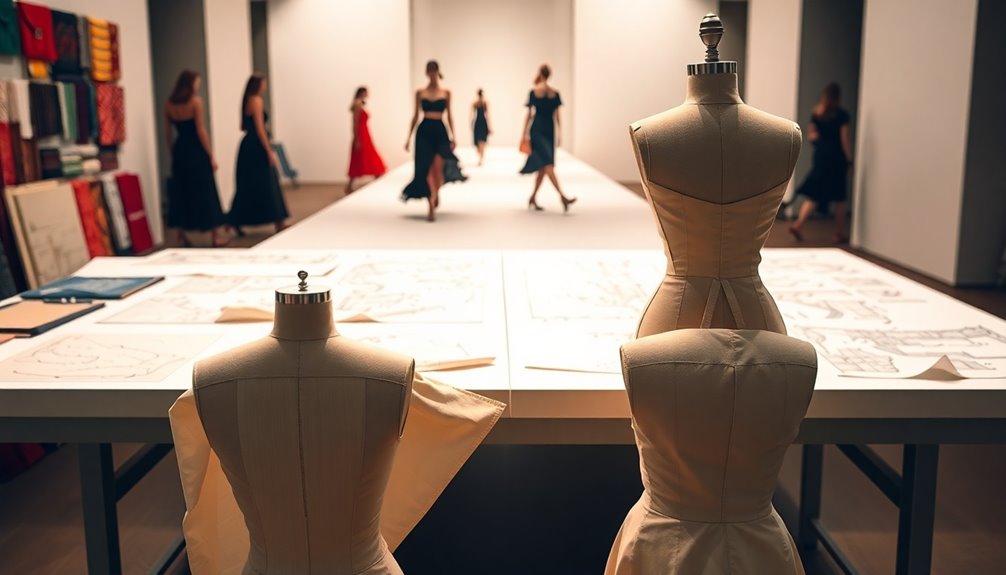
Flat pattern making is a vital technique that transforms your design ideas into tangible garments. This system involves creating 2-dimensional patterns that, when sewn together, yield a fit that flatters the body. You'll translate your flat fabric into a 3-dimensional garment, utilizing body measurements to draft a series of straight and curved lines that form the pattern.
Key components of flat patterns include elements like side seams and shoulder seams, which are typically straight, alongside curved lines for armholes and necklines. Understanding the apex of darts and the armscye—where the sleeve attaches—is crucial for achieving the right fit. Both slopers and blocks serve to perfect fit and facilitate new designs in the pattern making process.
To create flat patterns, plot points based on measurements that suit your design's end use, whether you're using fit model measurements or your own. You can start from scratch or manipulate basic patterns to explore new styles.
Mastering the process enables you to control your vision and accurately translate sketches into fabric. As a foundational skill in fashion design, flat pattern making enhances your understanding of fit, form, and construction techniques, paving the way for your creative success in the fashion industry.
Dress Form
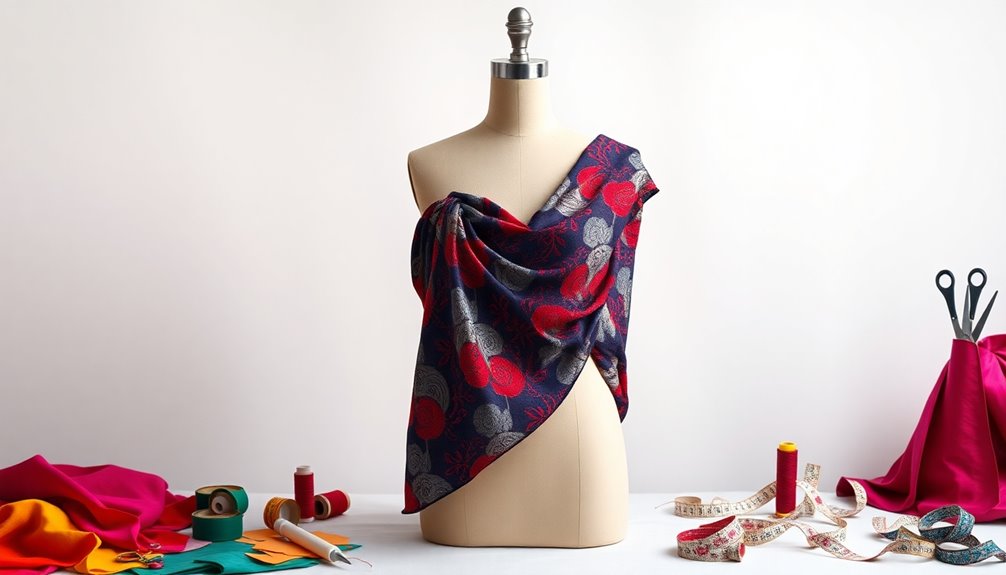
Dress forms serve as vital tools for fashion designers, allowing you to visualize how garments fit and drape on the human body. These three-dimensional models represent the torso, giving you a clear idea of how clothing will look on a real person. You can use them to make adjustments and alterations, ensuring a perfect fit for your creations.
Dress forms come in standard and adjustable models to accommodate various body types. For women, these forms are often called "Judy," while men's forms are referred to as "James." Accurate measurements are crucial; for women, you'll measure from the center of the shoulder seam to the bust point, and for men, from the shoulder seam to the waist front. The process of creating these forms involves accurate measurements and natural shape prototypes, which ensures that the dress form matches the intended fit.
The materials used for dress forms vary, ranging from muslin and brocade to DIY options like spandex. Adjustable forms allow for tailoring, while you can customize them further using padding or paper tape to match specific body shapes.
Ultimately, dress forms are essential not only for draping and pattern-making but also for visualizing design elements like asymmetry or ruching, ensuring your garments are both stylish and well-fitted.
Trimmings
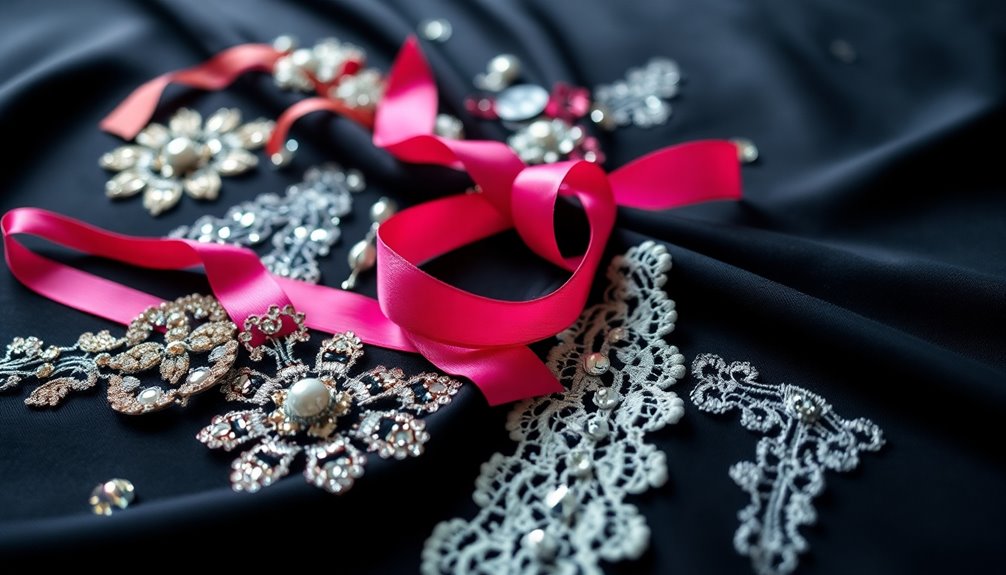
After perfecting the fit on your dress form, it's time to enhance your designs with trimmings. Trimmings add both functionality and flair to your garments, allowing you to showcase your unique style.
Visible trimmings, like buttons and zippers, serve essential fastening purposes while adding character to your designs. Labels give your creations a professional touch, offering branding and care information.
Don't overlook invisible trimmings; they provide stability and comfort. Garment interlining and lining help maintain shape and enhance wearability. Clothing fillers and padding improve structure, creating a polished look. Trimmings play a vital role in garment structure and design, contributing to the overall quality and appeal of clothing.
When it comes to decorative trimmings, think beads, sequins, and appliqué. These elements can elevate your design, making it visually striking. Tassels and fringe add movement and texture, while ruffles bring a soft, romantic touch.
Finally, consider functional trimmings like elastic bands and drawstrings. They ensure a great fit and usability, making your designs practical.
Standardized Sizing

Understanding standardized sizing is crucial for both designers and consumers navigating the fashion industry. Historically, sizing standards have evolved, starting with chest circumference as a primary variable. In the 1930s, initial attempts to standardize sizes by the US Government fell short, focusing only on semi-affluent white women.
The 1949 NBS study introduced the "Commercial Standard," officially recognized in 1957, which aimed to fit the largest number of people without alterations. However, the reality is that standardized clothing sizes are inconsistent across brands and even within the same brand. Modern sizing solutions have emerged to address these discrepancies, utilizing technology to enhance fit accuracy.
You'll find size charts that imply a standardized system, but variability remains due to cultural and racial diversity, making true standardization nearly impossible. For practical implementation, brands must measure their customer base and adjust size ranges accordingly.
Grading allows designers to scale sizes up and down while maintaining fit, but choices between alpha and numeric sizing depend on the target demographic and garment type. Alpha sizing simplifies options with letters, while numeric sizing provides more precision, particularly for tailored garments.
Understanding these nuances helps you navigate the often confusing world of fashion sizing.
Body Measurements
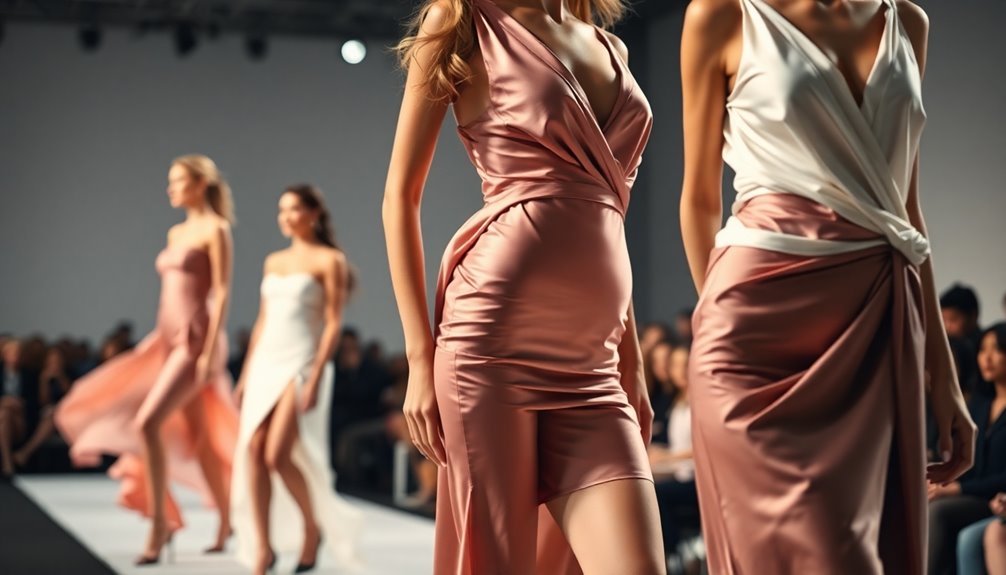
When it comes to fashion design, taking accurate body measurements is essential for creating garments that fit well and flatter the wearer. Start by measuring the bust or chest at its fullest part, ensuring the tape isn't too tight or loose.
Next, measure the waist just above the belly button, focusing on the smallest circumference. For the hips, wrap the tape around the widest part of the lower hip.
Don't forget to measure across the shoulders from one shoulder to the other, and from the highest point of the shoulder (HPS) to the apex of the bust. Always maintain an upright posture with your feet shoulder-width apart for consistency.
Use a flexible measuring tape and record measurements digitally for accuracy. Accurate measurements are crucial for ensuring effective fabric use and maintaining the quality of your garments.
Different garments require specific measurements: for tops and dresses, include bust, across shoulder, and neck-to-waist lengths. For bottoms, focus on hip, waist, and inseam lengths.
Accurate measurements are crucial not only for fit and style but also for maintaining fabric quality and garment durability. Remember, incorrect measurements can lead to costly adjustments and harm your brand's reputation.
Always aim for precision to ensure your designs shine!
Fit Session
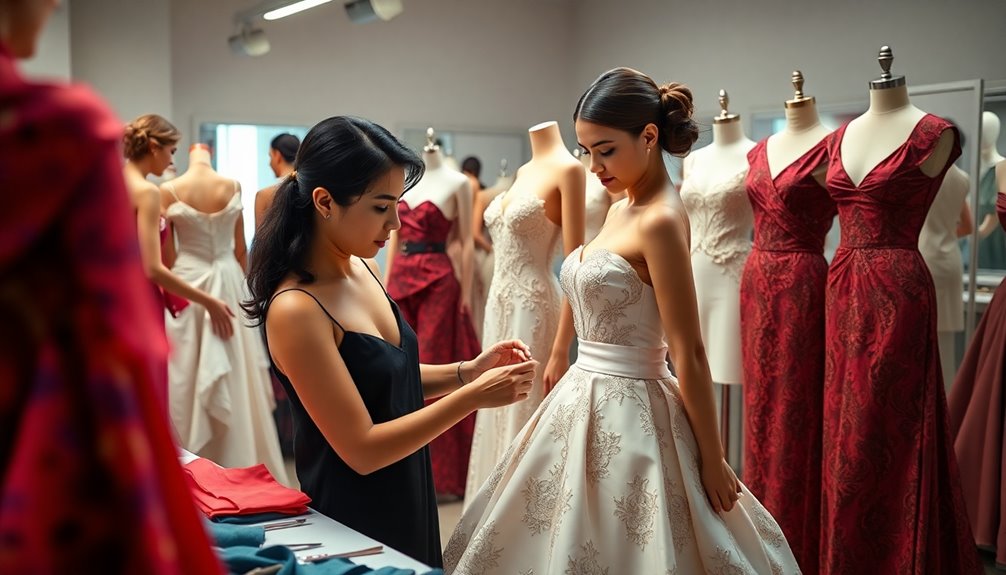
Accurate body measurements set the foundation for a successful fit session, where designers and technical teams evaluate how well sample garments conform to the intended design.
During these crucial meetings, you'll assess the fit of garments on a model that matches your target customer's size and shape. This process helps you identify design mistakes early, ultimately reducing production expenses and ensuring quality control. Fit sessions typically involve a model trying on the garments to provide real-time feedback on comfort and appearance.
Fit sessions can be held in person or remotely, using online tools. You'll gather feedback from the model regarding fit, comfort, and overall styling while comparing samples to reference garments.
As you review the key elements, focus on the garment’s fit, fabric quality, and any necessary adjustments. Document all observations using a Fit Sheet, which will guide communication with the pattern maker and manufacturer. After documenting the fit, fabric quality, and necessary adjustments, it’s important to also consult a fashion fabric guide to ensure that the garment’s specifications align with the desired outcome. This will help in selecting the right fabric that will enhance the overall look and feel of the garment. The fashion fabric guide will also provide valuable information on the properties of different fabrics, their drape, stretch, and durability, ensuring that the final product meets the intended design and quality standards.
Points of Measure
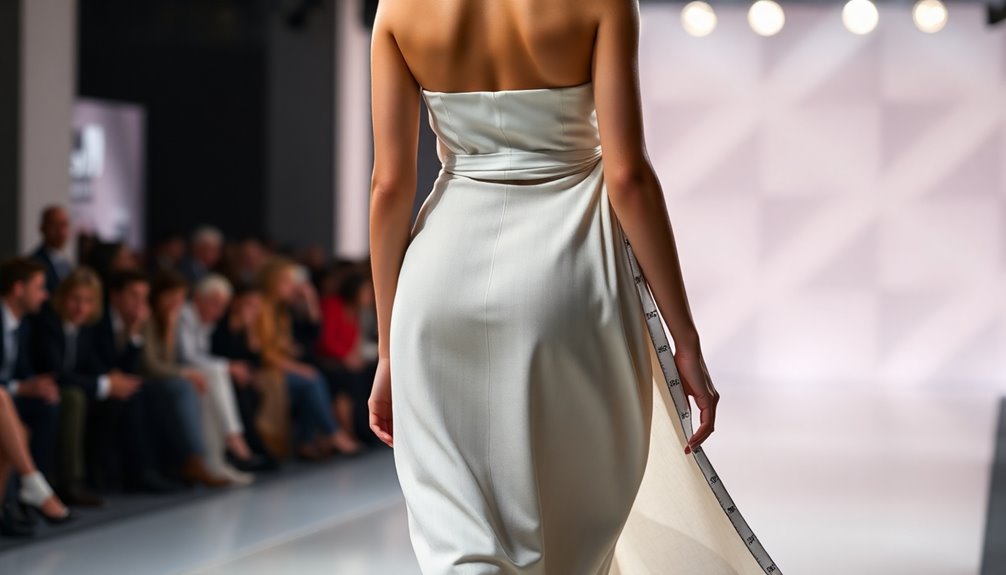
Points of Measure (POMs) play a crucial role in ensuring garments fit perfectly and meet design specifications. POMs are specific locations on a garment where you take measurements, which are essential for accurate fit and sizing. As a patternmaker or factory worker, you'll rely on these measurements to create patterns and produce garments that align with your design vision.
Different types of garments have unique POMs based on their style and fabric. For instance, a dress shirt requires measurements like collar size, sleeve length, and chest width, while pants focus on waistband circumference, hip width, and inseam length.
It's important to specify whether you measure along a straight or curved line and to clarify if you're including or excluding elements like frayed edges. Measurement tolerance is also critical, as it defines the acceptable range of variation for each POM measurement.
In garment production, POMs are part of the technical package and the spec sheet, which often includes a how-to measure guide. This guide helps ensure everyone involved understands how to accurately take measurements.
Factories use POM charts to create patterns, making it crucial to grasp fabric properties, including stretch, to achieve the right fit across different sizes. Understanding POMs is vital for successful garment development.
Size Gradings
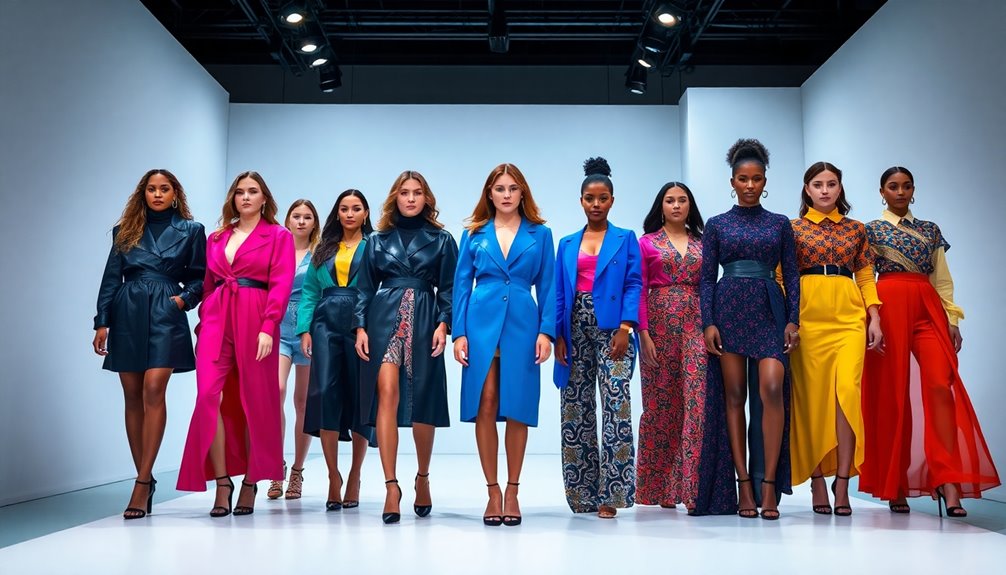
Understanding size gradings is essential for any fashion designer looking to create a well-fitted collection. Size grading involves systematically adjusting the measurements of a finished pattern to cater to different sizes while maintaining the garment's style and proportions. Starting with a middle-sized pattern as your base, you'll grade up or down to create larger and smaller sizes.
The grading process follows specific mathematical rules that dictate how much to add or subtract at various points on the pattern. This ensures each size fits well and retains its shape. You'll rely on a size chart or measurement table for accurate grading increments, which can vary based on factors like garment style and fabric type. Understanding grade rules is essential for achieving consistent fit across sizes.
When implementing size gradings, remember that smaller areas, like the neck, are typically graded in increments of 1/4" to 1/2", while larger areas, such as the chest, may use increments of 1" to 2". Certain components, like collar widths, remain consistent across sizes to maintain uniformity.
3D Fashion Design
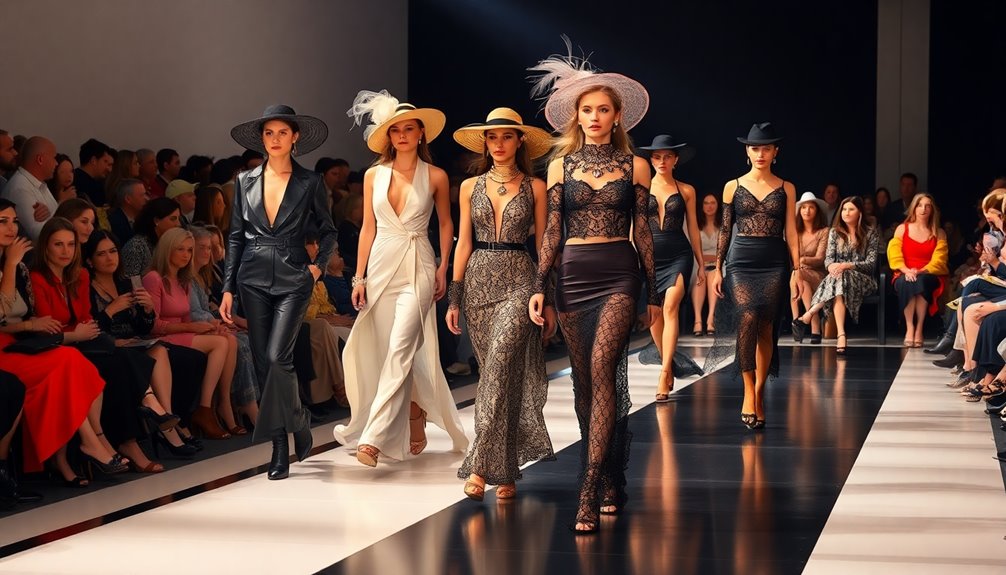
Diving into fashion design means exploring a vibrant blend of creativity and technical skill. At its core, fashion design is the art of bringing together aesthetics, clothing construction, and natural beauty to create apparel and accessories.
You'll find that fashion design evolves with culture and trends, varying over time and across different demographics. Additionally, designers conduct research to identify trends, which is crucial for anticipating future fashion directions.
As you delve deeper, you'll discover various types of fashion design. Haute couture represents exclusive, custom-made attire, while prêt-à-porter offers ready-to-wear options for the mass market.
Don't overlook costume design for film and theater, or specialized design focused on accessories like jewelry and shoes. Fast fashion is another area, characterized by its mass-produced, affordable clothing that reflects current trends.
The design process is equally fascinating. You'll engage in patternmaking, using techniques like draping and prototyping to refine your ideas.
Knowledge of materials, colors, and styles is essential, as is staying updated on market trends. Your role as a designer involves a mix of creative and technical tasks, collaborating with clients and teams to bring your vision to life.
Understanding these facets will set you on the path to success in the dynamic world of fashion design.
Tech Sketch
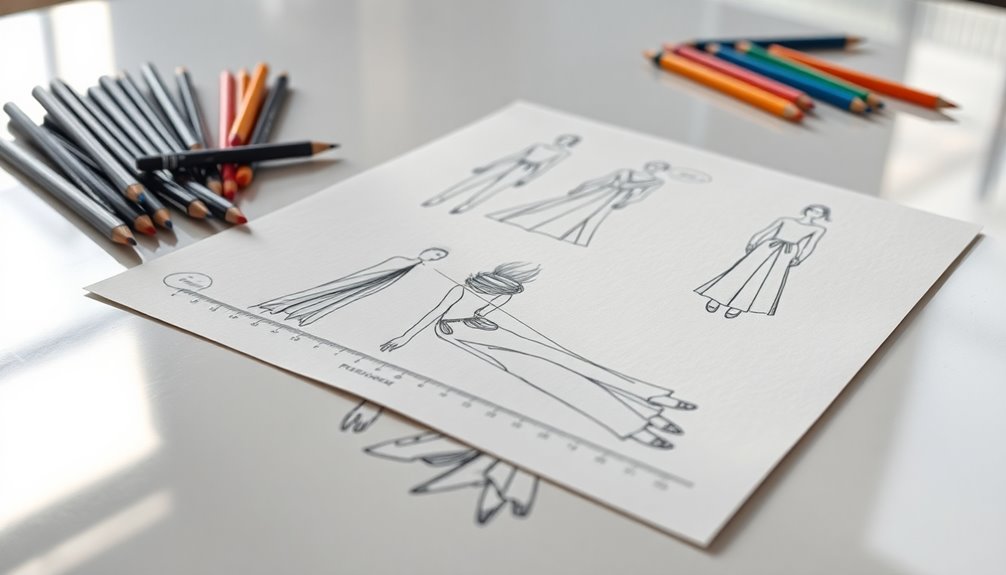
When it comes to fashion design, a tech sketch plays a crucial role in conveying detailed construction information. This technical drawing is essential for creating accurate prototypes and ensuring that all specifications are clear. Unlike other sketches, tech sketches focus on functionality over aesthetics, presenting the garment in a more mechanical way.
You'll find that a tech sketch includes specific measurements, seam placements, and stitching details, all depicted in black-and-white line drawings. The garment is typically shown laid flat, allowing for multiple views to provide a comprehensive understanding of its construction. Understanding each sketch type is crucial for effective design processes.
It's a valuable resource for designers, pattern makers, and sample makers, as it serves as a starting point for tech packs. While tech sketches were once confined to internal teams, their technical nature means they're less frequently shared externally today.
Instead, designers often opt for stylized flat sketches for broader communication. However, tech sketches remain indispensable for translating your creative ideas into tangible designs, ensuring smooth communication with manufacturers and accurate production.
Embracing the tech sketch will enhance your design process and elevate your fashion projects.
Colorway
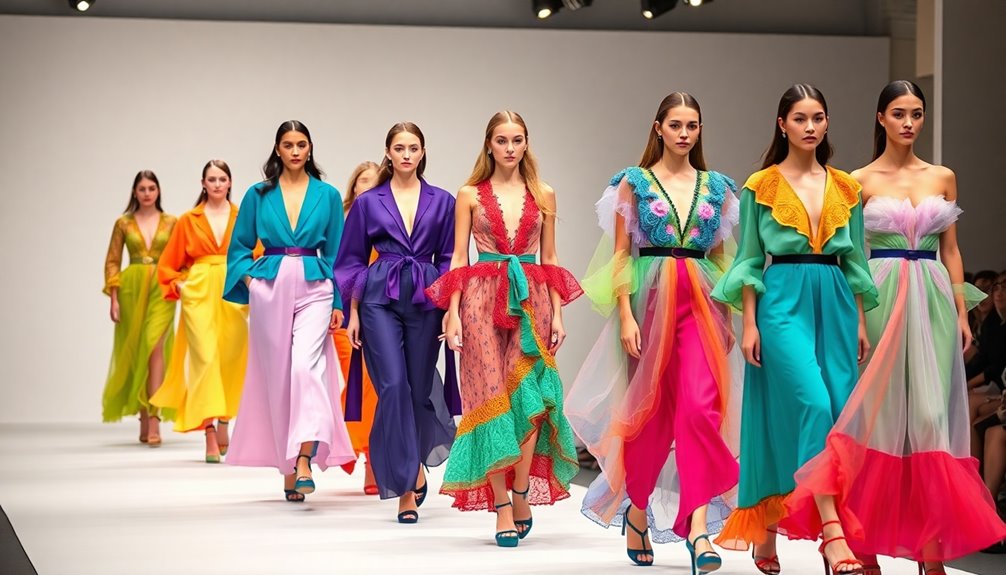
Colorway defines the specific color scheme or combination of colors used in a fashion product, significantly impacting its overall aesthetic and appeal. When you're designing or selecting items like sneakers, tops, or jackets, the colorway can make or break its popularity. Each colorway can feature multiple colors or variations of a single hue, creating unique options for consumers.
In the fashion world, colorways often reflect seasonal trends, allowing brands to stay relevant and appealing. You might notice different colorways released for the same model, giving you a choice that suits your style. Describing a colorway could involve terms like "predominantly blue tones" or "predominantly pink tones," showcasing its complexity compared to a single color.
It's crucial to understand that a colorway involves a combination or arrangement of colors rather than just one solid hue. This distinction helps in accurately conveying your design intentions. Additionally, the popularity of certain colorways can drive colorway demand and influence consumer choices, making it an essential aspect of fashion marketing.
In the industry, colorways play a vital role in product development and organization, integrating with terms like SKU to manage variations. By mastering this term, you enhance your fashion vocabulary and design communication skills.
Haute Couture
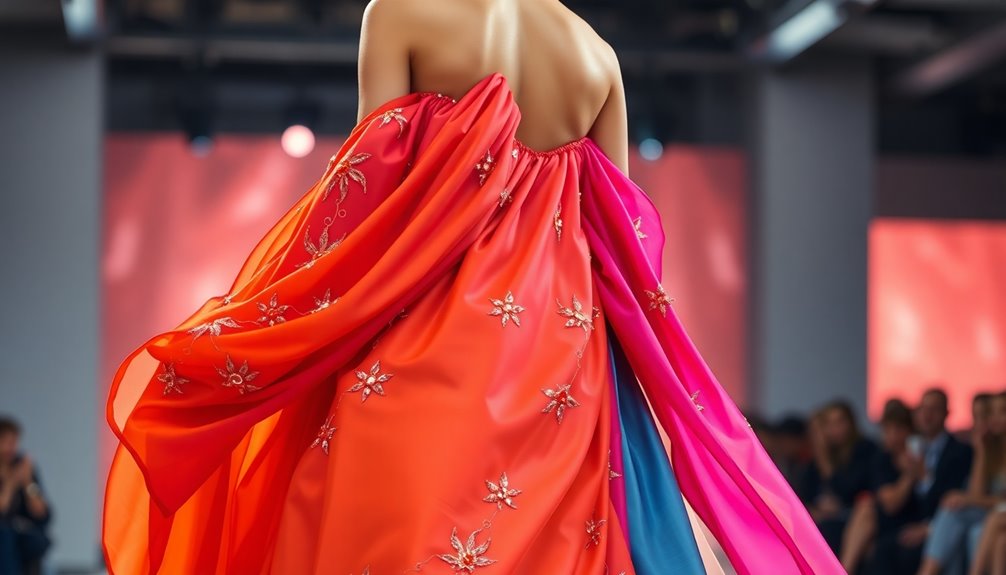
Haute couture represents the pinnacle of fashion design, where creativity meets unparalleled craftsmanship. Translated as "high sewing" in French, haute couture refers to exclusive, custom-fitted high-end fashion designs. While it originated in Paris, you'll find haute couture in other fashion capitals like New York, London, and Milan. This term encompasses both the designers and the unique fashions they create.
Each piece of haute couture is made-to-order for a specific customer, using the highest quality fabrics available. The production process demands extreme attention to detail and often involves intricate hand-executed techniques. Expect luxurious materials like exclusive laces to play a key role, ensuring that the garments fit you perfectly. Originality and exclusivity are hallmarks of this elite fashion segment. Additionally, minimum requirements like having fifteen employees in workshops are necessary for a fashion house to be designated as haute couture.
Historically, Charles Frederick Worth is recognized as the father of modern haute couture, establishing Paris as its center in the mid-nineteenth century. Haute couture has evolved into a protected term in France, regulated by the Chambre Syndicale de la Haute Couture, with stringent criteria for recognition.
Frequently Asked Questions
What Is the Difference Between Haute Couture and Ready-To-Wear?
The difference between haute couture and ready-to-wear lies in exclusivity and craftsmanship.
Haute couture involves custom-fitted, handmade garments designed for individual clients using high-quality materials, making it a luxury experience.
In contrast, ready-to-wear offers fashionable pieces produced in standard sizes for mass markets, prioritizing accessibility and affordability.
While haute couture represents the pinnacle of fashion artistry, ready-to-wear caters to a broader audience, balancing style with practicality.
How Do I Create a Mood Board for My Collection?
To create a mood board for your collection, start by defining your theme or concept. Gather inspiration from magazines, online platforms, and personal experiences.
Use a corkboard or digital tool to organize images, fabrics, and sketches cohesively. Arrange elements by color or texture to tell a story that aligns with your vision.
Finally, refine the board by adding a color palette and typography, ensuring it captures the mood you want to convey.
What Are the Key Elements of a Successful Fashion Show?
To create a successful fashion show, you need to focus on several key elements.
Start with a strong concept and theme that sets the tone. Choose an aesthetically pleasing venue with effective set design and lighting.
Select reliable models who embody your collection. Pay attention to sound and technical elements, ensuring everything flows seamlessly.
Finally, rehearse thoroughly to synchronize music, lighting, and model timing, creating an engaging experience for your audience.
How Can I Effectively Present a Collection Line-Up?
To effectively present your collection line-up, start with a strong theme that ties everything together.
Choose a venue that reflects this theme, and make sure your invitation is eye-catching and mobile-friendly.
Incorporate interactive elements, allowing guests to engage with your designs up close.
Use Instagram-worthy visuals and tell a compelling story through your presentation.
Lastly, follow up with a recap to keep the buzz alive after the event.
What Is the Purpose of Market Week in Fashion?
Market Week serves as a vital platform for you as a retail buyer to explore new collections and make purchasing decisions for the upcoming season.
You'll meet with both existing and new vendors, allowing you to establish crucial business connections.
This event's timing aligns with showcasing Spring/Summer or Fall/Winter collections, giving you the chance to review and order merchandise directly from designers and wholesalers, ensuring your store stays trendy and stocked.
Conclusion
Now that you're familiar with these 20 essential fashion design terms, you're better equipped to navigate the world of fashion. Understanding concepts like silhouette, mood boards, and tech packs will elevate your design skills and enhance your creativity. Whether you're sketching your next collection or discussing ideas with fellow designers, this knowledge will empower you to express your vision clearly. So, dive into your fashion journey, and let these terms guide you along the way!
